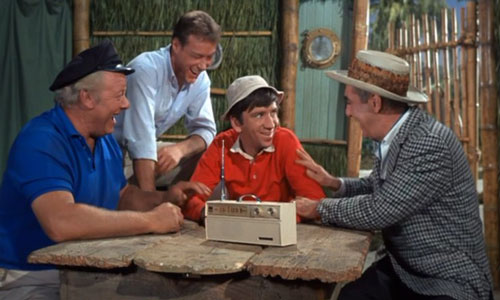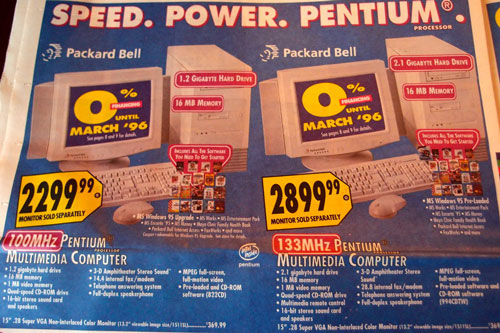The Many Lives of Packard Bell
When it was a radio-maker, Packard Bell had a reputation for quality products. When a PC clone startup bought the name, that reputation fell apart—fast.
“We didn’t want to be just another box-of-the-month. We felt we knew the PC market. If we could come into it with a nationally recognized name, we could be successful.”
— Larry Metz, a co-founder of the Packard Bell, discussing the company’s launch strategy. The firm, which began as a startup in 1986, relied on an unusual launch strategy. Simply, Metz and his fellow co-founder, Beny Alagem, took advantage of the existing brand recognition of an old-timey TV and radio manufacturer named Packard Bell. The public knew the company’s name—per the duo’s own brand research, Packard Bell had a name recognition of around 70 percent—but some merely recognized the name without much awareness of what the company actually did. That, according to Metz, was exactly the kind of brand recognition it was looking for. In a 1987 article on the company, InfoWorld referred to the company as “a new golden oldie.”

A Packard Bell radio, shown in a Gilligan's Island episode. (Warner Bros. Television Distribution)
What were the old Packard Bell radios and TV sets like?
Ever watch Gilligan’s Island with any sort of regularity? If so, you’ve likely seen a Packard Bell radio.
Whether a brilliant bit of product placement or sheer happenstance, the only form of communication that the show’s characters had with the outside world was a Packard Bell AR-851 AM transistor radio.
The device, which apparently wasn’t the producers’ first choice, has a bit of a cult following. To give you an idea: In 2009, a Lego fanatic named Dave Shaddix built a brick-style replica of the original radio, which went viral that year. The next year, magician David Copperfield, who has a Gilligan-themed room on his private island in the Bahamas (really), purchased the replica for his collection.
But Packard Bell wasn’t just known for Gilligan’s radio. The original form of the company came to life in the 1920s and the 1930s, selling vacuum-tube radios. Many of those early radios ended up in the hands of the U.S. military.
By the 1950s, it was producing some of the earliest modern television sets, eventually going to color. ( A 1964 Billboard article noted that the company was selling “the industry’s first color TV in wood cabinetry under $400.”) While the company slowly faded from view, becoming a subsidiary of the industrial conglomerate Teledyne, it was not with a whimper: In the early 1970s, the company played an important role in the release of the Cartrivision, a VHS predecessor that flopped in the market but proved informative for the home video industry.
Soon enough, Packard Bell lost its momentum, even if it still had its reputation for quality. It faded into Teledyne as a company with a name-brand reputation stronger than its sales.
It was a perfect name for a company that was trying to sell itself as reliable.
8,000
The number of stable sine waves the TRICE computer could produce per second, according to a report from the Office of Naval Research’s Digital Computer Newsletter. (TRICE, by the way, stands for “Transistorized Real Time Incremental Computer Expandable,” an acronym only a techie could love.) The mainframe machine, released by the original Packard Bell in 1958 and targeted at government agencies, highlights the fact that the original company did have some history in computers, even if it wasn’t with modern PCs. The Computer History Museum has a few images related to the TRICE, including a system brochure.

A Best Buy ad featuring two Packard Bell computers. (via the Packard Bell Planet wiki)
How Packard Bell took an old radio company’s reputation and drove it into the ground
If you can’t say anything else for the second coming of Packard Bell, you can say this: They came on fast.
In an era when computers were increasingly being sold through magazine ads, Packard Bell embraced the retail channel—tightly. As Best Buy was becoming a national chain and Sears was trying to make room for computing on its shelves, Packard Bell’s computers were a major piece of the digital puzzle. Less than a decade after the company launched, it had taken over the PC market.
And the company was quick to adapt to market changes. In a 1995 feature on the company in in Fortune, a CompUSA executive marveled at how quickly the firm was able to make changes to its product lines in response to direct feedback.
”In a business in which some companies can’t put out a new line in six months, they did it in two weeks,” the retail chain’s Larry Mondry recalled.
Part of the reason for this success was due to a tightly-wound manufacturing process, which allowed the company’s computers (which were manufactured in the U.S., by the way) to be early out of the gate with components like CD-ROM drives and Pentium processors. Their approach was pretty much the opposite of Apple’s Jobs-era one-computer-per-segment strategy, but also a bit different from Dell’s mail-order approach, as it relied on close relationships with big-name retailers.
Somewhat ironically, the company was helped along by its name being hard to place. Consumers unfamiliar with the name’s history in the retro electronics space assumed that the company was affiliated with Hewlett-Packard or one of the baby Bells. (It wasn’t.)
That gave Packard Bell the advantage of being a bit of a chameleon from a marketing perspective—something it took advantage of with its 1996 television commercial, which took a dim view on urban life (and more than a few cues from a certain Apple ad).
But one thing that Packard Bell’s second iteration didn’t share with its first was a reputation for quality.
The company’s reputation for fast iteration, treated as a badge of honor by Fortune, hid a tendency for the company’s products to break, as well as an extreme tendency to cut corners. This reputation even gained a hint of scandal when it was revealed in 1996 that the company repeatedly recycled components between different kinds of machines, leading to all sorts of lawsuits, hurting consumer perceptions, and causing an overall company decline.
Packard Bell tried to defend itself by suggesting that it wasn’t a big deal, but consumers weren’t buying it.
"I think consumers are a little confused about what recycled PC parts are," a spokesman told the South Florida Sun-Sentinel. "They are perfectly good, and they don't wear out like automobile parts do because they are not exposed to friction."
PC World, the magazine that broke the story about the recycled parts, did not have a high opinion of Packard Bell’s business strategy, even years after the machines left the U.S. market. The company’s computers—all of ‘em—topped a 2007 list of “The 10 Worst PCs of All Time.”
“When PC World decided to name the ten worst PCs of all time, it was a virtual lock that a Packard Bell machine would grace the list at number one,” the magazine’s Dan Tynan wrote. “The only question was, which model? It was an impossible choice.”
So they chose ‘em all.
40%
The decline that Packard Bell saw in its retail market share throughout 1996, a period in which Compaq overtook the company as the top retail PC-seller, according to research from Computer Intelligence reported by CNET. In 1996, Packard Bell began its slow descent into PC also-ran status—that year, the firm was acquired by NEC, which tried to rev up Packard Bell with new investments. But by 1999, NEC had enough of the massive losses it was taking on the brand, and it shut down the firm’s U.S. operations.
Packard Bell’s failure to maintain its status as a PC manufacturer of choice in the U.S. market comes down to a variety of factors, particularly the reputation for low quality.
“In the mid-’90s, the founders tried to build a mass-market business by selling lots of low-priced PCs,” Forbes’ David Einstein wrote in 1999. “But to keep costs down, they had to use cheap parts and cheap labor, and the result was cheap systems.”
But it also pointed out the firm’s inability to shift with the overall market. On the high end, established names like Hewlett-Packard and Compaq got closer to Packard Bell’s territory. On the low end, firms like eMachines lowballed Packard Bell’s machines significantly.
If there’s any consolation, it’s that the Packard Bell brand name has lived on in many markets outside of the United States, currently as a subsidiary of Acer—essentially in the same way that Acer uses its Gateway brand name in the U.S. But even Acer, which has a pretty solid brand name of its own, has let the legacy brands fall into disuse; last week the company took a writedown on its trademarks for both Gateway and Packard Bell.
No matter where things stand these days, Packard Bell as a name was worth something to U.S. consumers, however. And at least one company sees the potential for another comeback.
In August 2015, an obscure firm named JMM Lee Properties, LLC claimed in a press release it was about to manufacture new products under the Packard Bell name. It doesn’t appear to have gotten that far, but JMM Lee is in the market of licensing potentially valuable brands to new companies.
Perhaps they’re just waiting for the right startup that’s done its market research.
:format(jpeg)/2017/06/tedium122716.gif)
/2017/06/tedium122716.gif)

/uploads/ernie_crop.jpg)